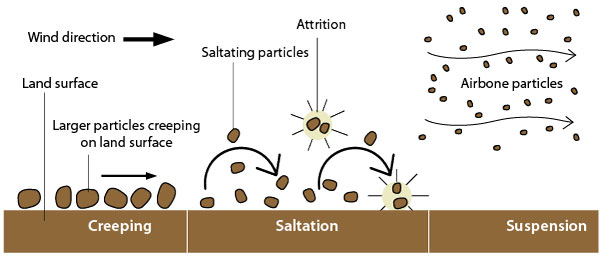- Landforms
The process of wind erosion
Wind erosion is simply the removal of soil particles from the surface of the land and transporting them to another location. When the force of the wind is exerted on a land surface, the soil moves. The extent of movement depends on the amount of soil moved depends on the size of the soil particles, the cloudiness of the soil particles, and the velocity of the wind (wind velocity). Wind erosion occurs in three processes known as creeping, saltation, and suspension.
Creeping:
Creeping (or surface creep) is when soil particles larger than 0.5mm in diameter are dragged over the surface of the land because they are too heavy for the wind to lift. As the particles roll and move along the surface, they bump into each other.
Saltation:
In a saltation process, the particles involved are between 0.1mm to 0.5mm. The wind can lift them briefly but drops them in very short intervals. This results in a hop and bounce motion over the surface. Sometimes as the particles fall, they bounce back up and continue the routine. Particles can also bounce into others and set them into motion too. Saltating particles cause Attrition. Attrition is when the bouncing and jumping particles knock against each other in flight and break themselves up. This wear and tear can go on until the particles become fine or dust particles.
Suspension:
This process involves particles (fine dirt and dust) that are less than 0.1mm in diameter. The wind can carry these particles over very long distances. It is probably the most common form of wind action and also the easiest to recognize. Suspension causes abrasion or sandblasting – when particles in suspension polish surfaces that get in their way. Abrasion is more powerful close to the land surface and less effective with 0objects higher up the ground.
